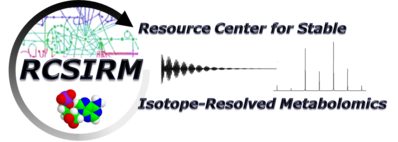You are here: Moseley Bioinformatics Lab>RCSIRM Web>WebHome (27 Feb 2019, HunterMoseley)
 |
 |
Recent News and Upcoming Events
- The 2018 Metabolomics Workshop was held July 22, 2018 – August 3, 2018
- The 2018 Metabolomics Symposium was held on July 30, 2018
- Read about Core-Director Teresa Fan in the latest NIH Common Fund Research Grantee Success Stories.
- Read and watch a video about a potential new drug target for lung cancer discovered by RC-SIRM members.
- Check out our interview in MedicalResearch.com.
What is Metabolomics?
Living cells are maintained under non-equilibrium conditions, which requires constant input of energy. The cells must also maintain their infrastructure, and perform tissue-specific tasks, all of which need energy and raw material. Metabolism is the set of processes that convert exogenous compounds to metabolic energy, which drives biochemical reactions within the cell, maintains homeostasis, provides the means to do work (e.g. contraction, movement, action potentials, secretion and so forth), for cellular repair, and to divide. Metabolism responds to exogenous signals as represented by diet and pollutants for example, and local environments (microenvironment) as represented by the conditions prevailing outside cells in tissues. As such, metabolism is a sensitive indicator of pathology.
Therefore, the ability to measure global metabolism in quantitative detail is of fundamental importance in all aspects of biology. Metabolomics provides the technical means to carry out global analyses of metabolism, by identifying and quantifying a large fraction of all of the metabolites present in a cell, and how they change in response to perturbations within relevant metabolic networks. Metabolomics therefore requires high-end analytical instrumentation, of which mass spectrometry and NMR together are the most appropriate technologies. Informatics is the third critical component of metabolomics to interpret the observations in a biological context. Careful sample preparation and processing is the often overlooked first critical component in metabolomics, which is necessary to prevent excessive perturbation and degradation of the observed metabolites. And appropriate experimental design and adherence to this design is the zeroth critical component of metabolomics.
Therefore, the ability to measure global metabolism in quantitative detail is of fundamental importance in all aspects of biology. Metabolomics provides the technical means to carry out global analyses of metabolism, by identifying and quantifying a large fraction of all of the metabolites present in a cell, and how they change in response to perturbations within relevant metabolic networks. Metabolomics therefore requires high-end analytical instrumentation, of which mass spectrometry and NMR together are the most appropriate technologies. Informatics is the third critical component of metabolomics to interpret the observations in a biological context. Careful sample preparation and processing is the often overlooked first critical component in metabolomics, which is necessary to prevent excessive perturbation and degradation of the observed metabolites. And appropriate experimental design and adherence to this design is the zeroth critical component of metabolomics.
What is Stable Isotope-Resolved Metabolomics (SIRM)?
Global metabolomics, the quantification of a large number of metabolites in tissue or biofluids can identify disease states or response to therapeutics by reference to the normal condition. However, determining specific mechanisms, such as detecting which pathways are impacted in particular cell types within a tissue by measuring metabolic fluxes, requires additional information as many metabolites are present in different amounts in different cell types or within compartments of cells, as well as participating in several pathways simultaneously. To identify the precursor-product relationships, it is necessary to distinguish different sources of carbon, nitrogen etc. which necessitates some means of “labeling” individual atoms so that their fate can be traced through metabolic pathways. Traditionally this was achieved using radioisotopes. However, stable isotopes have several advantages, including being wholly biocompatible, and also individual atoms within a metabolite are easily distinguishable by NMR and mass spectrometry.
The general approach we have developed, which we call Stable Isotope Resolved Metabolomics or SIRM, combines the power of global (untargeted) metabolic profiling with atom-resolved tracking of metabolites during metabolic transformations within cells, tissue or whole organisms. The cell culture, tissue, or organism is provided with a source metabolite that is enriched at any or all of the atoms with a stable isotope (like 13C or 15N with natural abundances 1.1 % and 0.37%, respectively), and the products are analyzed by NMR and MS at different times after treatment. The specific isotopomer and isotopologue distributions in the various product metabolites are determined, along with the total amounts of the metabolites, which together provide detailed information about the relative importance of intersecting and parallel pathways. For example, lactate can be produced directly from glucose by lactic fermentation, as well as by glutaminolysis; the relative contributions from these independent pathways is readily determined from the isotope distributions in the lactate using either 13C-enriched glucose or glutamine as labeled sources. At the same time such labeling schemes provide simultaneous information about the flow of carbon through the pentose phosphate pathway, glycolysis, hexosamine pathway, the Krebs cycle and lipid biosynthesis among others.
The general approach we have developed, which we call Stable Isotope Resolved Metabolomics or SIRM, combines the power of global (untargeted) metabolic profiling with atom-resolved tracking of metabolites during metabolic transformations within cells, tissue or whole organisms. The cell culture, tissue, or organism is provided with a source metabolite that is enriched at any or all of the atoms with a stable isotope (like 13C or 15N with natural abundances 1.1 % and 0.37%, respectively), and the products are analyzed by NMR and MS at different times after treatment. The specific isotopomer and isotopologue distributions in the various product metabolites are determined, along with the total amounts of the metabolites, which together provide detailed information about the relative importance of intersecting and parallel pathways. For example, lactate can be produced directly from glucose by lactic fermentation, as well as by glutaminolysis; the relative contributions from these independent pathways is readily determined from the isotope distributions in the lactate using either 13C-enriched glucose or glutamine as labeled sources. At the same time such labeling schemes provide simultaneous information about the flow of carbon through the pentose phosphate pathway, glycolysis, hexosamine pathway, the Krebs cycle and lipid biosynthesis among others.
Topic revision: r8 - 27 Feb 2019, HunterMoseley
 Copyright © by the contributing authors. All material on this collaboration platform is the property of the contributing authors.
Copyright © by the contributing authors. All material on this collaboration platform is the property of the contributing authors. Ideas, requests, problems regarding Moseley Bioinformatics Lab? Send feedback
